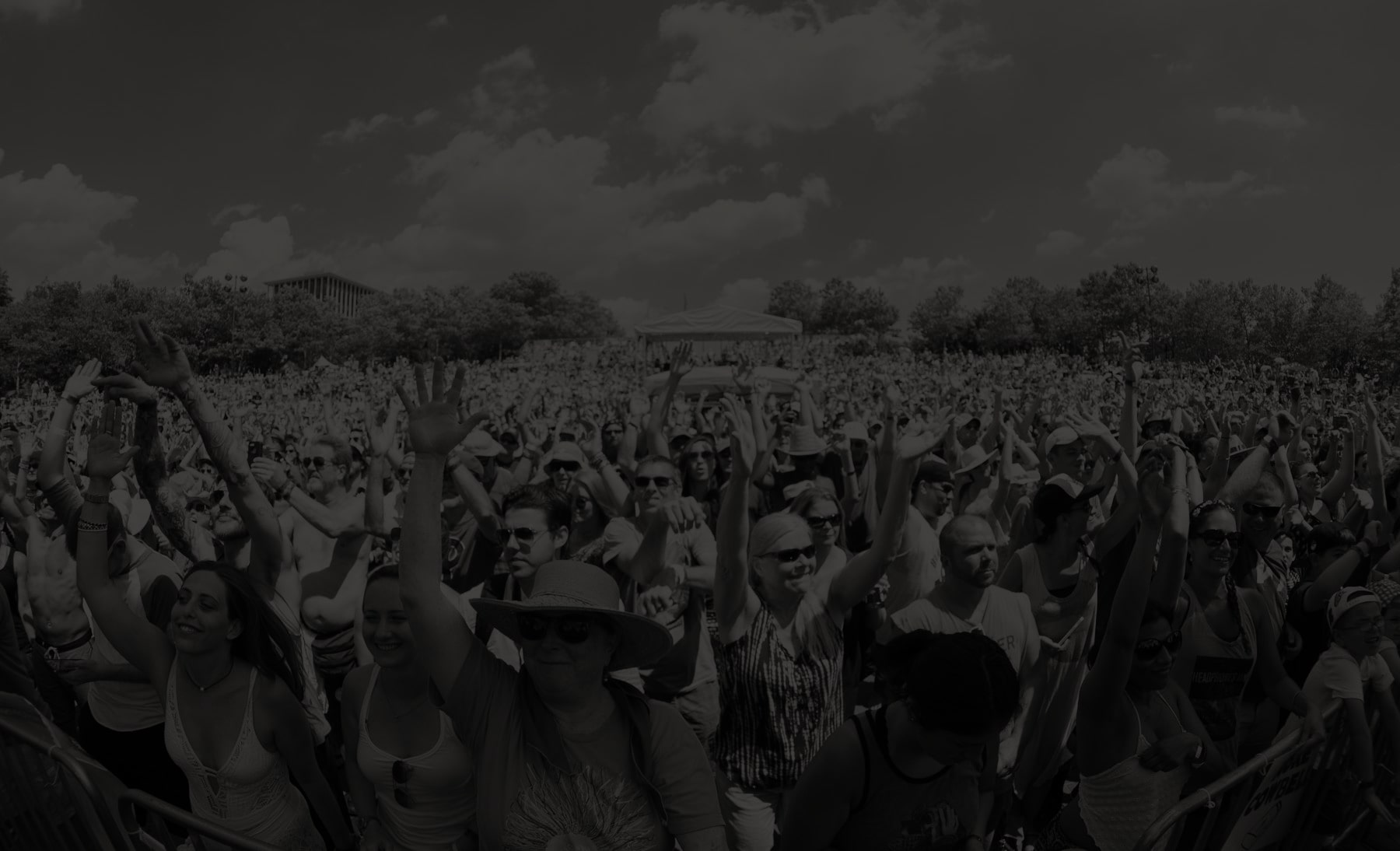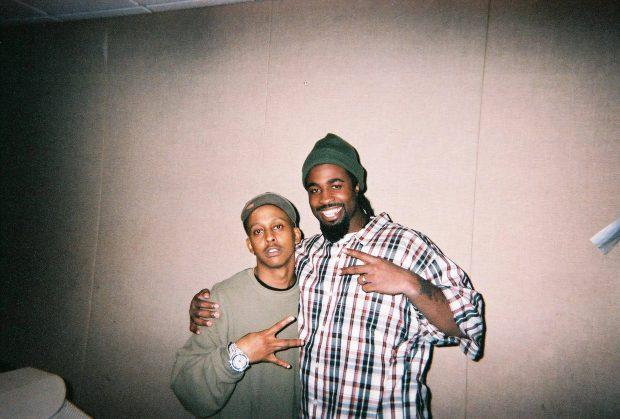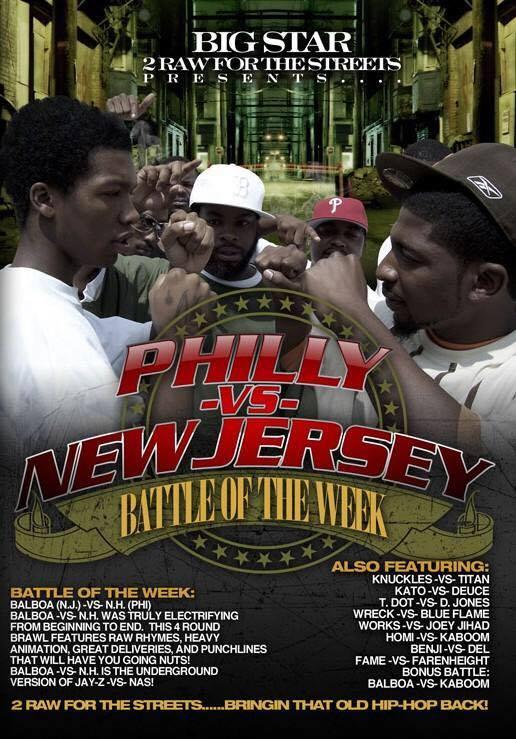
2 Raw For The Streets: How Big Star pioneered the hip-hop DVD era in 2000s Philly
“According to the odds or statistics, I should be in a mental ward. But I weathered the storm and by the grace of God, I survived.” – Michael “Big Star” Starling.
Born in Norristown Pa, the youngest of 3 siblings, Michael Starling was a loner. An active, imaginative kid, he spent his days busy with sports and fed his curiosity on a steady diet of classic kung fu flicks, Blaxploitation movies and hip-hop. It was this early love of sports, film and music that would provide an escape from the chaos that reigned in his household — and would lead him to launch 2 Raw For The Streets, an underground video series that documented the burgeoning Philadelphia hip-hop community.
By the time Starling was a teenager, his siblings had all grown up and left home, leaving Starling alone his mother as she struggled with schizophrenia.
“It was madness at the crib with my Mom,” he recalled. “I’d stay in school as long as I could, after school, because I didn’t want to go home. I knew that in order to get a breath of fresh air, I had to go away as soon as I graduated. I love my mom, but mentally, I needed some space or I was gonna crack.”
After being recruited to Alvernia University in Reading, Starling left after one semester and enrolled in West Chester University. A self-described “book nut,” Starling excelled scholastically, while struggling financially. “I was broke as a joke,” he says. “I heard through the grapevine that I could get a job with the work study program. I wanted to work in the library. Unfortunately, the last library job was taken, but the on-campus TV station was available. I didn’t want to work at the TV station, but it was the last job available and it paid minimum wage, so I took it. That was the best decision I ever made in my life.”
Starling never went to film school. He is 100% self-taught. Because the campus studio would close at 6 p.m., he would stay in there after work until 2 or 3 a.m. After countless hours spent learning the ropes filming and editing baseball and field hockey games on campus, Starling’s curiosity had blossomed into a full fledged loved of film.
Determined to shoot more, he took his financial aid refund check and bought a camera of his own. It was the mid 90s, and Starling would often find himself spending his summers and weekends in Philly, filming the sights and sounds of the infamous Greek Picnic (an annual event members of Black Fraternities and Sororities from around the country would converge upon the city for a week, drawing crowds that topped 100,000) and hanging out on South Street filming the rappers who would cypher and battle out on the street.
“I became known as ‘Star with the camera,’” Starling says. “Whatever we were doing, I was filming it. Pranking each other, guys cyphering, whatever.”

Big Star filming an early 2 Raw For The Streets DVD | photo courtesy of Michael “Big Star” Starling
It was during this time that he also began meeting and building a network of young, up-and-coming rappers from Philly and Norristown who were attending West Chester as well as HBCUs (Historically Black Colleges and Universities) like Cheney and Lincoln. Camera in hand, Starling would arrive on campus, scope the kids who looked like hip-hop heads and / or rappers, and begin filming them spitting lengthy freestyles over extended beats that he would manually loop using two tape decks.
During this time, Starling had not only amassed a catalog of VHS tapes that featured some of the area’s brightest young talent, he had also unwittingly set in motion a course of events that would shape the direction of the rest of his life.
“My library started to grow and guys started coming by my dorm like ‘yo Star, put on that one tape with the guys rapping.”
As word spread around school, Starling found himself with kids lining up outside of his dorm room for a chance to pop in and catch a verse from one of his homemade tapes. Starling offered to make a classmate a custom tape in order to buy himself some peace and quiet time to study. “There was no editing software or anything like that,” he says. “I edited it together using two VCRs. When I gave him the tape, he turned to me and said ‘yo bro, here’s $5’ and a lightbulb went off in my head. I thought ‘I wonder who else will give me $5 for these tapes’. I got inspired, I just felt led to create more copies. There were no covers, it was just a SONY VHS tape.”
After more students began offering him money for their own copies, Starling decided that it was time to step up his production game. His first offering, created in 1998, was a compilation of freestyles including Kre Forch and his partner Dex Dill at Cheney and a variety of street scenes.
“I would just document everything,” Starling recalls. “Rap wasn’t even the primary focus. Fights, summer league basketball, an old wino on the corner telling war stories….everything hood. Rap wasn’t even the focus. It was all so raw and that’s how I think I came up with the name.”
View this post on Instagram
After painstakingly editing together this collage-like mini-documentary of life in the hood, he designed his own DIY cover and labeled the tape 2 Raw For The Streets. As word of mouth (and demand) spread, Star would make connections and build relationships with local up and coming MCs who were hungry for a platform to showcase their skills. Starling and his camera soon became a ubiquitous presence, shedding light on a growing movement of street music centered around an intense poetic style of rhyming that was growing in the city and surrounding areas.
This gritty, specifically Philly-born style was miles away from much of the pop-rap that glided across urban radio’s airwaves at the time. By focusing on and highlighting the underground, Starling had brilliantly exploited a vacuum, creating a visual equivalent to the street mixtapes that dominated New York hip-hop in the mid-to-late 90s.
“There was no blueprint,” recalls Philly rapper Freeway. “The only place you could hear your favorite rapper was on a Clue tape, DJ S&S.”

DVD cover for the Hell Up In Philly edition of 2 Raw |photo courtesy of Michael “Big Star” Starling
As the deep and diverse cadre of MC’s that Starling had met and built relationships with continued to grow, the series’ notoriety spread, opening the door for him to connect with rappers in West Philly, South Philly, Southwest, Uptown and North Philly.
“We was the first ones to bring Star to the hood,” says Freeway, speaking on how his pre-State Property group Ice City appeared on some of the earlier 2 Raw tapes. “He would come to our hood with the camera and it’d be me, Indy 500 and Peedi Crakk.” It was at this point Starling started to look into getting his tape from the streets into record stores for wider distribution.
“I walked into Sounds of Norristown, that was owned by a guy by the name Marty Gibbs, and I said ‘yo Marty, I want to see if I can get my tapes in here for sell,'” Starling remembers. “Mind you, there was nothing like it. He only sold music, CDs and cassette tapes and that’s it. He didn’t understand it, guys from the industry weren’t on it and he didn’t think it was a money maker. So he turned me away, he didn’t think that he could sell them, there weren’t so my man Chris started working at the store and he knew what I was doing, he knew how hot the tapes were. He said, ‘I’ma put the tapes in the store for you on the consignment tip, and if they sell, I’ll get you paid.’”
As Starling recalls, it started from that one store. “The backbone of music then was the street vendors, the guys who sold mixtapes on the [outdoor] stands and the mom and pop record stores. Funk-o-mart, Continuous Motion, Armand’s. They ran the music and connected it to the community.”
View this post on Instagram
Once Starling’s first run of tapes began selling out on the streets and stores, he secured wider distribution throughout the tri-state area through Gibbs’ organization known simply as The F.I.R.M. (Family of Independent Record Merchants), which was a large conglomerate of music retailers. As the late 90s gave way to the dawn of the millennium, DVDs were established as the primary video medium: a vast, grassroots economic and cultural network had grown out Starling’s passion for filming rappers. This came at a time when lyricism in Philly was evolving at a rapid pace, with MCs packing their bars full of clever wordplay and vivid, street-oriented imagery. As more 2 Raw DVDs sold, more rappers wanted to get on camera for a chance to display their skills for fame and notoriety. This two-sided dynamic set the foundation for the development of a community but also intense competition.
“This was before social media so it was by word of mouth,” remembers Ab LIva of Major Figgas. “I heard there was a guy going around recording the hottest Philly rappers. I couldn’t wait to get the call.”
The now-classic installments of the 2 Raw series like PA’s Most Wanted, Starface, Starlito’s Way, Hell Up in Philly, and Heavyweight Champs featured a host of MCs that embodied a new wave of Philly hip-hop. Reed Dollaz, Tana Da Beast’s A.T. (Assault Team, featuring Jakk Frost, Joe5, Buddha Bless Sy Bey), Sandman (Cannons Inc), Hollowman (Erie Ave.), Slaughter Rico, Gillie Da Kid, E Ness, Team A (Cyssero, Sicko Hollowman) and more left behind moments that live in on Philly Hip Hop lore, like Vodka’s classic “Show Off” freestyle, the infamous Garage Battle , the Barbershop battle and many many more.

Gillie Da Kid and Big Star | photo courtesy of Michael “Big Star” Starling
From the scores of young men honing their skills circled on Philly street corners in long white tees and fitted hats to major label artists like Cassidy, Ms. Jade and Beanie Sigel’s State Property crew — which featured Freeway, Oschino & Sparks, Peedi Crakk, Young Chris and Neef — Starling’s series captured the violent, ecstatic energy of the city at the dawn of the millennium. To get an idea of just how diverse the city’s music scene was at the time, consider the fact that while 2 Raw’s brand of hardcore street music was buzzing, the equally impactful neo-soul sound of Jill Scott, Kindred The Family Soul and the Jazzyfatnastees had also emerged out of The Roots’-backed Black Lily open mic. Not since the days for Gamble & Huff’s Philadelphia International had Philly received so much national and international attention for its homegrown music scene. At the time, it felt like the city and the boundless creativity that animated it lived at the center of the music world.
Despite all of the attention his films and the artists he showcased were receiving, Starling’s life began to change dramatically. After marrying his girlfriend Keisha and having a child, he began to deepen his relationship to his faith and family.
“I got married in 2004. It was like every weekend I was running the streets with the camera and I was away from home all the time,”Starling remembers. “I didn’t want to miss critical things like my son’s tee-ball games. I was going to church or bible study learning about the word and its impacting me, I’m feeling it. God was just taking my life in a different direction. My life was changing. My heart was changing.”
As a result of this change, Starling struggled to reconcile his new outlook with the subject matter featured on his DVDs, which was often violent and centered around the criminality that comes along with life in the streets. In addition to being brilliant, poetic minds, many of the young men featured on his DVDs were living the life that they rapped about. At the time, many beefs between individuals and their respective crews had erupted with the opening shots verbally fired on Star’s camera. In Philadelphia, rapping on camera became more than just an artistic sport, the competition over beats reflected (and antagonized) deep tensions in the street.
“To hear guys talking about the violence and killing each other and drugs, it was just conflicting with my spirit,” recalls Starling. “People would call me like ‘Yo, Star, such and such got shot, this guy got killed. They were having a rap battle and it turned to a fight’. That stuff just got on my nerves and broke my heart. I didn’t sign up for that. ”
With all of these forces pulling at him, Starling gradually began to step away from 2 Raw For the Streets.

DVD cover for the Philly Vs. New Jersey edition of 2 Raw | courtesy of Michael “Big Star” Starling
“I wasn’t good with telling people no, I wasn’t good with goodbyes. My cellphone was the hotline, I stopped answering it. Stopped returning people’s voicemails. I slowly stopped circulating the DVDs to the stores. I rode off into the sunset and didn’t look back.”
In his absence from the music scene, Starling led an unassuming life with his wife and kids, working a 9 to 5 job and living in Harrisburg, a long way from the streets, when had a moment reminiscent of the encounter that got him started at West Chester way back in ’98.
“I have four boys and I’m a sports dad,” he says. “All my boys play sports. When I left 2 Raw for the Streets, I didn’t film anything. I picked the camera back up when my boys started playing sports. I was filming one of my son’s games and a lady says to me ‘hey sir, are you selling those?’ I said ‘don’t worry about it, I’ll make you a copy on DVD’ I see her at the next practice and she gave me $10. So, all of a sudden I’m filming every game and all the parents are like ‘yo, Big Star, you filming the game?’”
Still imbued with a passion for film and capturing developing talent through his Raw Sports Films YouTube channel and film production company, Starling spent the past few years documenting rising high school basketball and football stars in the area.
Throughout the years, the model that Starling had established flourished. Philly-based DVDs like Young Bob’s Headshots series continued to give light to an even younger generation of prodigious street rappers. Battle rap leagues like URL used this once-underground movement to build massive fan bases, even launching rap battle events via pay per view. In the wake of YouTube’s founding in 2005, many 2 Raw fans began to rip their old DVDs, uploading these classic freestyles and battles to the platform and acting as unofficial archivists of this critical movement in hip-hop history. It was through this process that 2 Raw and Philly’s street / battle rap styles began to gain more recognition from the world at large, with many 2 Raw stars such as Reed Dollaz, Cyssero, Kaboom and Frank wit da Grippaz Gone continuing to make noise on the battle circuit.
With YouTube and Instagram accounts such as Philly F.A.M.E. and Heavy Spitters doing crucial work archiving Philly’s 2000s rap scene (now commonly referred to as “the DVD era”) while highlighting new, up and coming lyricists, 2 Raw For the Streets and the moment in Philly hip-hop history that it documented have become legendary.
In August of 2018, Starling reconnected with this legacy by launching a 2 Raw For the Streets page on Instagram. In a relatively short time, the page’s reach has grown exponentially (over 11K followers in a little over 4 months) speaking to the popularity and impact of the series. In addition to the reposts and comments from well-known rap stars like A$AP Ferg and Meek Mill (who cut his teeth during the DVD era), you’ll see fans and 2 Raw alumni sharing memories and stories of their favorite verses, battles and moments.
Despite changes to technology, the industry and some radical shifts in the pop-cultural landscape, Starling’s work has lived on as an early blueprint and foundational element of contemporary Hip Hop and digital media. In part two of this series, we will touch on Big Star’s return and explore the influence of 2 Raw for the Streets with personal recollections from the artists who lived this moment of Philly hip-hop history.